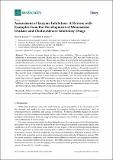Files in this item
Assessment of enzyme inhibition : a review with examples from the development of monoamine oxidase and cholinesterase inhibitory drugs
Item metadata
| dc.contributor.author | Ramsay, Rona R. | |
| dc.contributor.author | Tipton, Keith F. | |
| dc.date.accessioned | 2017-07-18T11:30:13Z | |
| dc.date.available | 2017-07-18T11:30:13Z | |
| dc.date.issued | 2017-07 | |
| dc.identifier | 250484001 | |
| dc.identifier | 06b7ab06-ab80-491b-9b1f-fc1c834f70f3 | |
| dc.identifier | 85042431862 | |
| dc.identifier | 000406621300166 | |
| dc.identifier.citation | Ramsay , R R & Tipton , K F 2017 , ' Assessment of enzyme inhibition : a review with examples from the development of monoamine oxidase and cholinesterase inhibitory drugs ' , Molecules , vol. 22 , no. 7 , 1192 . https://doi.org/10.3390/molecules22071192 | en |
| dc.identifier.issn | 1420-3049 | |
| dc.identifier.uri | https://hdl.handle.net/10023/11236 | |
| dc.description | Both authors are grateful for the collaborations on multi-target drugs facilitated by COST Action CM1103 (2011-2015). | en |
| dc.description.abstract | The actions of many drugs involve enzyme inhibition. This is exemplified by the inhibitors of monoamine oxidases (MAO) and the cholinsterases (ChE) that have been used for several pharmacological purposes. This review describes key principles and approaches for the reliable determination of enzyme activities and inhibition as well as some of the methods that are in current use for such studies with these two enzymes. Their applicability and potential pitfalls arising from their inappropriate use are discussed. Since inhibitor potency is frequently assessed in terms of the quantity necessary to give 50% inhibition (the IC50 value), the relationships between this and the mode of inhibition is also considered, in terms of the misleading information that it may provide. Incorporation of more than one functionality into the same molecule to give a multi-target-directed ligands (MTDLs) requires careful assessment to ensure that the specific target effects are not significantly altered and that the kinetic behavior remains as favourable with the MTDL as it does with the individual components. Such factors will be considered in terms of recently developed MTDLs that combine MAO and ChE inhibitory functions. | |
| dc.format.extent | 46 | |
| dc.format.extent | 10250298 | |
| dc.language.iso | eng | |
| dc.relation.ispartof | Molecules | en |
| dc.subject | Alzheimer’s disease | en |
| dc.subject | l-deprenyl (selegiline) | en |
| dc.subject | Donepezil | en |
| dc.subject | Galantamine | en |
| dc.subject | Inhibitor constant | en |
| dc.subject | Enzyme inhibition | en |
| dc.subject | Multitarget-directed ligand (MTDL) | en |
| dc.subject | Rasagiline | en |
| dc.subject | Rivastigmine | en |
| dc.subject | QH301 Biology | en |
| dc.subject | QH426 Genetics | en |
| dc.subject | RM Therapeutics. Pharmacology | en |
| dc.subject | Biochemistry | en |
| dc.subject | Chemistry (miscellaneous) | en |
| dc.subject.lcc | QH301 | en |
| dc.subject.lcc | QH426 | en |
| dc.subject.lcc | RM | en |
| dc.title | Assessment of enzyme inhibition : a review with examples from the development of monoamine oxidase and cholinesterase inhibitory drugs | en |
| dc.type | Journal item | en |
| dc.contributor.sponsor | European Commission | en |
| dc.contributor.institution | University of St Andrews. School of Biology | en |
| dc.contributor.institution | University of St Andrews. Biomedical Sciences Research Complex | en |
| dc.identifier.doi | https://doi.org/10.3390/molecules22071192 | |
| dc.description.status | Peer reviewed | en |
| dc.identifier.grantnumber | oc-2010-2-8526 | en |
This item appears in the following Collection(s)
Items in the St Andrews Research Repository are protected by copyright, with all rights reserved, unless otherwise indicated.

